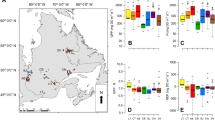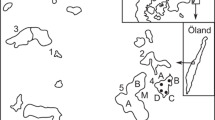Abstract
Nineteen small lakes located in open landscapes or deciduous forests in nutrient-rich calcareous moraines in North Zealand, Denmark, were all net heterotrophic having negative net ecosystem production and predominant CO2 supersaturation and O2 undersaturation of lake waters. Forest lakes were poorer in nutrients, phytoplankton, and primary production, but richer in dissolved organic matter and CO2 than open lakes with more light available. The modeled annual balance between gross primary production and community respiration (GPP/R COM) averaged 0.60 in forest lakes and 0.76 in open lakes and the ratio increased significantly with phosphorus concentration and phytoplankton biomass but decreased with colored dissolved organic matter. The negative daily rates of ecosystem production resembled estimates of oxygen uptake from the atmosphere to the lakes, whereas estimates of CO2 emission were 7.2-fold higher. Although CO2-rich groundwater and anaerobic respiration support greater molar release of CO2 than uptake of O2, we suggest CO2 emission is overestimated. Possible explanations include CO2 enrichment of the air film above small wind-sheltered lakes. The observed metabolism and gas exchange show that exogenous organic matter is an important supplementary energy source to community respiration in these small lakes and that forest lakes, in addition, experience pronounced light attenuation from trees and dissolved colored organic matter constraining primary production.





Similar content being viewed by others
References
Algesten, G., Sobek, S., Bergström, A.-K., Ågren, A., Tranvik, L.J. and Jansson, M. 2003. Role of lakes for organic carbon cycling in the boreal zone. Glob Chang Biol 10:141–147.
Bade, D. L., and J. J. Cole 2006. Impact of chemically enhanced diffusion on dissolved inorganic carbon stable isotopes in a fertilized lake. J Geophys Res 111:C1.
Carpenter, S.R., Cole, J.J., Kitchell, J.F. and Pace, M.L. 1998. Impact of dissolved organic carbon, phosphorus, and grazing on phytoplankton biomass and production in experimental lakes. Limnol Oceanogr 43:73–80.
Christensen JCB. 2000. CO2 in streams, concentrations and fluxes (in Danish). MS Thesis, Freshwater Biological Laboratory, University of Copenhagen
Christensen, D.L., Carpenter, S.R., Cottingham, K.L., Knight, S.E., LeBouton, J.P., Schindler, D.E., Voichick, N., Cole, J.J. and Pace, M.L. 1996. Pelagic responses to changes in dissolved organic carbon following division of a seepage lakes. Limnol Oceanogr 41:553–559.
Closter RM. 2007. Influence of weather and expected future changes on thermal stratification and anoxia in Danish lakes. Ph.D. Thesis, University of Copenhagen
Cole, J.J. and Caraco, N·F. 1998. Atmospheric exchange of carbon dioxide in a low-wind oligotrophic lake measured by the addition of SF6. Limnol Oceanogr 43:647–656.
Cole, J.J., Caraco, N·F., Kling, G.W. and Kratz, T.K. 1994. Carbon dioxide supersaturation in the surface waters of lakes. Science 265:1568–1570.
Cole, J.J., Pace, M.L., Carpenter, S.R. and Kitchell, J.F. 2000. Persistence of net heterotrophy in lakes during nutrient addition and food web manipulation. Limnol Oceanogr 45:1718–1730.
Cuthbert, I.D. and del Giorgio, P. 1992. Toward a standard method of measuring color in freshwater. Limnol Oceanogr 37:1319–1326.
Del Giorgio, P.A., Cole, J.J., Caraco, N·F. and Peters, R.H. 1999. Linking planktonic biomass and metabolism to net gas fluxes in northern temperate lakes. Ecology 80:1422–1431.
Dillon, P.J. and Molot, A. 1997. Dissolved organic and inorganic carbon mass balances in central Ontario lakes. Biogeochemistry 36:29–42.
Duarte, C.M. and Agusti, S. 1998. The CO2 balance of unproductive aquatic ecosystems. Science 281: 234–236.
Duarte, C.M. and Kaff, J. 1989. The influence of catchment geology and lake depth on phytoplankton biomass. Arch Hydrobiol 115:27–40.
Duarte, C.M. and Prairie, Y.T. 2005. Prevalence of heterotrophy and atmospheric CO2 emissions from aquatic ecosystems. Ecosystems 8:862–870.
Fee, E.J., Hecky, R.E., Kasian, S.E.M. and Cruikshank, D.R. 1996. Effects of lake size, water clarity, and climatic variability on mixing depths in Canadian Shield lakes. Limnol Oceanogr 41:912–920.
Fisher, S.G. and Likens, G.E. 1973. Energy flow in Bear Brook, New Hampshire: an integrative approach to stream ecosystem metabolism. Ecol Monogr 43:421–439.
Frew NM, Bock EJ, Schimpf U, Hara T, Haussecker H, Edson JB, McGillis WR, Nelson RK, McKenna SP, Uz BM, Jahne B. 2004. Air-sea gas transfer: its dependence on wind stress, small-scale roughness, and surface films. J Geophys Res 109:CO8S17
Huisman, J. and Weissing, F.J. 1994. Light-limited growth and competition for light in well-mixed aquatic environments. Ecology 75:507–520.
Jackson, T.A. and Hecky, R.E. 1980. Depression of primary productivity by humic matter in lake and reservoirs of the boreal forest zone. Can J Fish Aquat Sci 37:2300–2317.
Jähne, B., Münnich, O., Bösinger, R., Dutzi, A., Huber, W., and Libner, P. 1987. On the parameters influencing air-water gas exchange. J Geophys Res 92:1937–1949.
Jensen, S.E. 2000. Agroclimate at Taastrup 2000. Agrohydrology and Bioclimatology. Department of Agricultural Science. Life, University of Copenhagen, Copenhagen.
Jonsson, A., Meili, M., Bergstrøm, A.-K. et al. 2001. Whole-lake mineralization of allochthonous and autochthonous organic carbon in a large humic lake (Örträsket, N. Sweden). Limnol. Oceanogr. 46: 1691–1700.
Jonsson, A., Karlsson, J. and Jansson, M. 2003. Sources of carbon dioxide supersaturation in clearwater and humic lakes in northern Sweden. Ecosystems 6: 224–235.
Jonsson, A., Algesten, G., Bergström, A.-K., Bishop, K., Sobek, S., Tranvik, L.J. and Jansson, M. 2007. Integrating aquatic carbon fluxes in a boreal catchment carbon budget. J. Hydrol. 334: 141–150.
Kirk, J.T.O. 1994. Light and photosynthesis in aquatic ecosystems. 2nd. ed. Cambridge University Press, Cambridge.
Kling, G.W., Kipphut, G.W., Miller, M.C. 1991. Arctic lakes and streams as gas conduits to the atmosphere—implications for tundra carbon budgets. Science 251: 298–301.
Krause-Jensen, D. and Sand-Jensen, K. 1998. Light attenuation and photosynthesis of aquatic plant communities. Limnol. Oceanogr. 24: 1038–1050.
Larsen, S.E. et al. 1995. Ferske vandområder – vandløb og kilder (in Danish). Vandmiljøplanens Overvågningsprogram 1994. Danmarks Miljøundersøgelser, Silkeborg, Denmark.
Liss, P·S. and Merlivat, L. 1986. Air-sea gas exchange rates: Introduction and synthesis. In: P. Baut-Menard (ed.), The role of air-sea gas exchange in geochemical cycling. D Reidel, Dordrecht, The Netherlands
McConnaughey, T.A., LaBaugh, J.W., Rosenberry, D.O. et al. 1994. Carbon budget for a groundwater-fed lake: Calcification supports summer photosynthesis. Limnol. Oceanogr. 39: 1319–1332.
Pace, M.L., Carpenter, S., Cole, J.J. et al. 2007. Does terrestrial organic carbon subsidize the planktonic food web in a clear-water lake? Limnol. Oceanogr. 52: 2177–2189.
Parsons T.R., Maita Y. and Lalli C.M. 1984. A manual of chemical and biological methods for seawater analysis. Pergamon, New York, USA.
Plummer, L. N., and E. Busenberg 1982. The solubilities of calcite, aragonite and vaterite in CO2-H2O solutions between 0°C and 90°C, and an evaluation of the aqueous model for the system CaCO3-CO2-H2O. Geochim. Cosmochim. Acta 46: 1011–1040.
Rebsdorf Aa. 1972. The carbon dioxide system in freshwater. Booklet of tables, Freshwater Biological Laboratory, Univ. of Copenhagen, Denmark.
Rubbo, M.J., Cole, J.J. and Kiesecker, J.M. 2006. Terrestrial subsidies of organic carbon support net ecosystem production in temporary forest ponds: evidence from an ecosystem experiment. Ecosystems 9: 1170–1176.
Sand-Jensen, K. and Frost-Christensen, H. 1998. Photosynthesis of amphibious and obligately submerged plants in CO2-rich lowland streams. Oecologia 117: 31–39.
Sand-Jensen, K. and Pedersen, N.L. 2005. Differences in temperature, organic carbon and oxygen consumption among lowland streams. Freshwat. Biol. 50: 1927–1937.
Sand-Jensen K. and Staehr P.A. 2007. Scaling of pelagic metabolism to size, trophy and forest cover in small Danish lakes. Ecosystems. 10: 128–142.
Sand-Jensen, K., Brodersen, P., Madsen, T.V., Jeppesen, T.S. and Kjøller, B. 1995. Plants and CO2 supersaturation in streams (in Danish). Vand og Jord 2: 72–77.
Schindler, D.E., Carpenter, S.R., Cole, J.J., Kitchell, J.F. and Pace, M.L. 1997. Influence of food web structure on carbon exchange between lakes and the atmosphere. Science 277: 248–251.
Sobek, S., Algesten, G., Bergström, A.-K., et al. 2002. The catchment and climate regulation of pCO2 in boreal lakes. Global Change Biology 9: 630–641.
Sobek, S., Tranvik, L. J. and Cole, J. J. 2005. Temperature independence of carbon dioxide supersaturation in global lakes. Global Biogeochemical Cycles 19: 1–10.
Søndergaard, Ma., Jeppesen, E. and Jensen, J.P. 2005. Pond or lake: does it make any difference? Arch. Hydrobiol. 162: 143–165.
Straskraba, M. 1980. The effects of physical variables on freshwater production: Analyses based on models. In: The functioning of freshwater ecosystems. Edited by E.D. la Cren and R.H. Lowe-McConnell. Cambridge University Press, Cambridge, U.K. pp. 13–84.
Strickland JDH, Parsons TR. 1968. A practical handbook of seawater analysis, vol 167. Fish Res Bd Can, Ottawa, Canada
Stumm, W. and Morgan, J.J. 1996. 3rd ed. Aquatic chemistry: Chemical equilibria and rates in natural waters. Wiley-Interscience. New York.
Talling, J.F. 1957. The phytoplankton population as a compound photosynthetic system. New Phytologist 56: 133–149.
Torgersen T, Branco B. 2007. Carbon and oxygen dynamics of shallow aquatic systems: process vectors and bacterial productivity. J Geophys Res 112:G03016
Torgersen T, Branco B. 2008. Carbon and oxygen fluxes from a small pond to the atmosphere: temporal variability and the CO2/O2 imbalance. Water Resour Res 44:WO2417
Tranvik, L.J. 1992. Allochthonous dissolved organic matter as an energy source for pelagic bacteria and the concept of the microbial loop. Hydrobiologia 229: 107–114.
Vadeboncoeur, Y., D. M. Lodge, and S. R. Carpenter 2001. Whole-lake fertilization effects on distribution of primary production between benthic and pelagic habitats. Ecology 82: 1065–1077.
Vadeboncoeur, Y., E. Jeppesen, M. J. Vander Zanden, H. H. Schierup, K. Christoffersen, and D. M. Lodge 2003. From Greenland to green lakes: Cultural eutrophication and the loss of benthic pathways in lakes. Limnol. Oceanogr. 48: 1408–1418.
Acknowledgments
This project was funded by a grant from the Danish Natural Science Research Council to KSJ. We are grateful for technical assistance from Birgit Kjøller and helpful comments to improve the manuscript by Anders Jonsson and Jeremy Testa. We are impressed by the insight and constructiveness of Stephen Carpenter, Jonathan Cole, and three anonymous referees.
Author information
Authors and Affiliations
Corresponding author
Additional information
Kaj Sand-Jensen (KSJ) formulated the original research idea and designed the study. Data analysis (ie. calculations, statistics and figures) was performed by Peter A. Staehr (PAS). The text was for the most part written by KSJ, although with contributions by PAS, especially in describing the applied methods and data analysis.
Rights and permissions
About this article
Cite this article
Sand-Jensen, K., Staehr, P.A. Net Heterotrophy in Small Danish Lakes: A Widespread Feature Over Gradients in Trophic Status and Land Cover. Ecosystems 12, 336–348 (2009). https://doi.org/10.1007/s10021-008-9226-0
Received:
Revised:
Accepted:
Published:
Issue Date:
DOI: https://doi.org/10.1007/s10021-008-9226-0




